March 1, 2019
Air Date: March 1, 2019
FULL SHOW
SEGMENTS
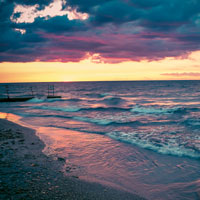
Lake Erie Wins Legal Rights
View the page for this story
The citizens of Toledo, Ohio have taken a major step to protect Lake Erie, which provides their drinking water. They voted by a wide margin to grant the lake and its watershed legal rights, so that people can bring lawsuits to court on behalf of the lake itself. Tish O'Dell, from the Community Environmental Legal Defense Fund, which helped draft Toledo’s charter amendment, joins Host Steve Curwood to discuss the Lake Erie rights and other places that have been granted legal “rights of nature”. (09:39)
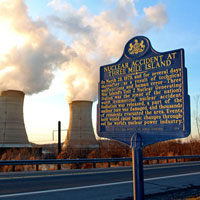
Beyond the Headlines
/ Peter DykstraView the page for this story
For this week's trip beyond the headlines, Peter Dykstra joins Host Steve Curwood to discuss the growing waste crisis that’s been worsened by China’s decision to no longer accept recycling from the U.S. Then, they talk about the generational impacts DDT and other endocrine disrupting chemicals may have in relation to breast cancer. And in the history vault, they look back to the uncanny timing of the Three-Mile Island atomic power plant crisis and the release of the film “The China Syndrome”, which focused on the impacts of a fictional nuclear power plant disaster. (04:32)

Volkswagen Goes All-Electric
View the page for this story
After its 2015 diesel emissions scandal, Volkswagen has announced an all-electric car factory in the United States, with manufacturing to begin in 2022. This is all part of the German car manufacturer’s plan to stop making gas and diesel-powered cars by 2026. Jim Motavalli, freelance writer and blogger for NPR's Car Talk, joins host Steve Curwood to talk about the future of electric cars and the new Volkswagen--“people’s car”. (08:25)
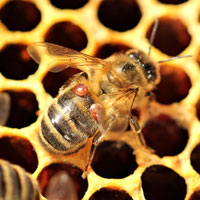
Science Note: Using Mushrooms to Save The Bees
/ Aynsley O'NeillView the page for this story
A single Varroa mite can bring down an entire honeybee hive by infecting an individual bee with the Deformed Wing Virus. But researchers are now seeing that certain mushroom extracts can be used to treat these infected bees, as Aynsley O’Neill reports in this week’s Note on Emerging Science. (01:42)
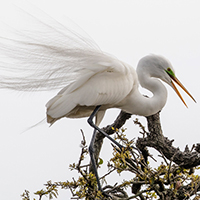
A Great Egret’s Mating Dance
/ Mark Seth LenderView the page for this story
As spring approaches in Florida, male Great Egrets are practicing showing off their snowy white plumage for mates. Living on Earth’s Explorer in Residence, Mark Seth Lender, bears witness (03:07)
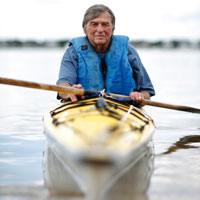
Remembering Dick Wheeler and the Great Auk
View the page for this story
In 1991 Richard Wheeler fulfilled a lifelong dream and paddled his kayak along the migratory route of the now-extinct Great Auk from Newfoundland to Buzzard's Bay, Massachusetts. He dedicated much of his later years to supporting local conservation efforts and paddling through new adventures. Living on Earth pays a tribute to the late Wheeler, who died in February 2019, with a reprise of the story of his journey tracing the migration route of the Great Auk. Dick Wheeler teamed up with famed storyteller Jay O'Callahan to help him tell the story, and both men joined host Steve Curwood in the studio to recount the remarkable journey. (19:11)
Show Credits and Funders
Show Transcript
HOST: Steve Curwood
GUESTS: Jim Motavalli, Jay O’Callahan, Tish O’Dell, Dick Wheeler
REPORTERS: Peter Dykstra, Mark Seth Lender, Aynsley O’Neill
[THEME]
CURWOOD: From Public Radio International – this is Living On Earth.
[THEME]
CURWOOD: I’m Steve Curwood.
After living for days with unsafe water, Toledo, Ohio votes to create a bill of rights for the source of their drinking water, Lake Erie.
O’DELL: People woke up to not only, like, a water boil alert. This was much worse. They said do not touch the water, that it could make you sick. It meant no drinking it obviously, but also no showers, no washing your clothes in it, no washing dishes. So, no water use whatsoever.
CURWOOD: Also, remembering Dick Wheeler and his search for the migration route of the extinct Great Auk.
O’CALLAHAN: He wanted to make a 1,500-mile kayak journey, from northern Newfoundland, a place called Funk Island all the way down to Buzzard's Bay. Well, I've grown up by the sea, and I knew that was almost impossible.
CURWOOD: That and more this week on Living on Earth – Stick Around!
[NEWSBREAK MUSIC: Boards Of Canada “Zoetrope” from “In A Beautiful Place Out In The Country” (Warp Records 2000)]
[THEME]
Lake Erie Wins Legal Rights
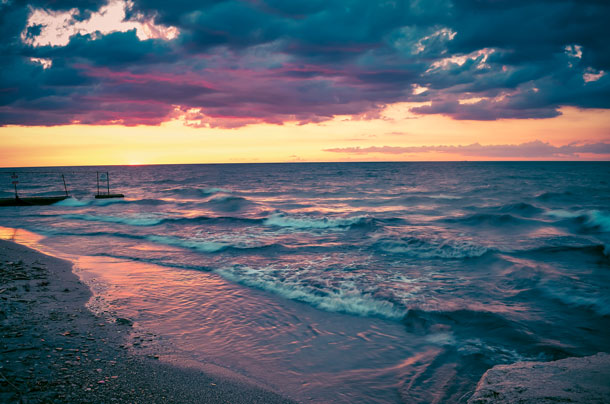
Lake Erie is the eleventh largest lake in the world, and provides drinking water to some 12 million people in the United States and Canada. (Photo: Jen Goellnitz, Flickr, CC BY-NC-ND 2.0)
CURWOOD: From PRI and the Jennifer and Ted Stanley Studios at the University of Massachusetts Boston, this is Living on Earth. I’m Steve Curwood.
By a wide margin the citizens of Toledo, Ohio, have voted to amend the city charter to grant the Lake Erie watershed legal rights. This comes after a toxic algal bloom on the Lake fouled the city water supply in August of 2014 and touched off near-panic, as CNN reported at the time.
CNN REPORTER 1: Imagine waking up this morning and thinking, Can I use my water? Can I take a shower? Can I have some coffee? I don't know.
CNN REPORTER 2: That's the reality, though. For nearly half a million people across Northwest Ohio, they’re being warned not to use, drink, cook, even boil, amazingly enough, the tap water.
CNN REPORTER 1: The advisories come after a dangerous toxin was discovered in a local water treatment plant there and that led the governor to declare states of emergency across the state. Even the National Guard has been called in to help bring safe water.
CURWOOD: Toledo has now granted the Lake Erie watershed legal rights, much the way corporations and municipalities have legal rights and standing in court, even though they are not persons. It is meant to allow people to sue on behalf of the lake and its tributaries. The likely targets of such a suit would be sources of pollution including industrial byproducts and fertilizer runoff from agriculture. There was a battle up to the Ohio Supreme Court to get the Lake Erie Bill of Rights on Toledo’s ballot, delaying it past the November elections. Immediately after the special election a local farming concern filed suit in federal court, seeking to invalidate Lake Erie’s newfound rights on constitutional grounds. But Lake Erie is not alone, as legal rights for nature are emerging world wide. Some seek protection for species such as primates and whales, while others protect rivers and entire ecosystems. Joining us now from Toledo is Tish O’Dell, Ohio Community Organizer for the Community Environmental Legal Defense Fund. Welcome to Living on Earth, Tish!
O’DELL: Thanks for having me, Steve.
CURWOOD: So please, share with us some of the history of Lake Erie. How long has its battle with pollution been going on?
O’DELL: Well, let's see, my entire life, I believe. I mean, we had problems back in the 60s, there were some steps taken. And I know people, they remember Lake Erie, and the Cuyahoga River catching on fire, and then they go, well, it doesn't catch fire anymore. And my response to that always is, well, that's a pretty low standard, isn’t it?
CURWOOD: Indeed. Now, 2014, you had a massive algal bloom in the lake, nearby the city of Toledo, and Toledo couldn't use its city water. Tell me that story, please.
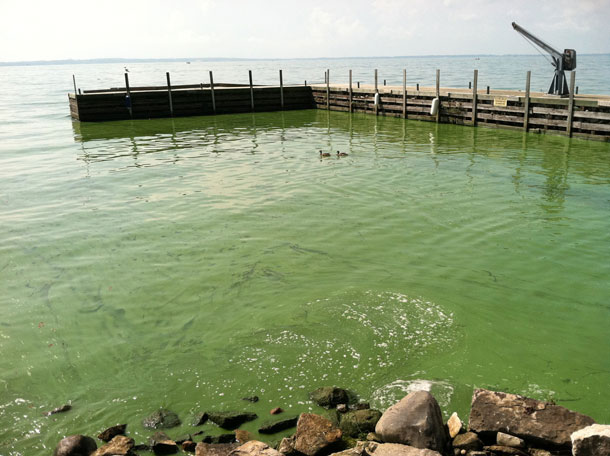
In 2014, because of a particularly dangerous algal bloom, the citizens of Toledo were unable to use their tap water for three days, sparking the movement to grant Lake Erie legal rights. (Photo: T. Joyce, NOAA, Wikimedia Commons, CC BY-SA 2.0)
O’DELL: Yeah, the people woke up to all kinds of warnings and alerts. To, not only like a water boil alert, something like that, this was much worse. They said do not touch the water, that it could make you sick, so it meant no drinking it obviously, but also no showers, no washing your clothes in it, no washing dishes. So no water use whatsoever. I mean, and it was almost a real panic. Because unless you've been through that, I mean, you don't know what that's like to not have any water whatsoever to use. And so, of course, people went to the stores and started hoarding all the water, the shelves emptied. You know, they were driving 45 minutes away to try and purchase water, because no one knew how long it was going to last. It went for three days.
CURWOOD: It went on for three days. You just couldn't use any water at all.
O’DELL: Mmhmm.
CURWOOD: So what sparked the movement to give Lake Erie and its watershed this particular legal standing?
O’DELL: Well, back in Toledo, in 2014, the people in Toledo, they spent two years from 2014 to ‘16, the people there living through that were very scared that this was going to happen again. Because every summer we still have algae blooms. So you know, even three days after that, they said, okay, it's safe to drink the water. And you still have those doubts in your mind. And, you know, it's like is it really safe to drink? The government in the two years, what they did, they would throw things like more money, you know, taxpayer dollars and say, well, you know, we're gonna test the waters more often, so that, you know, we can add more chemicals quicker so it doesn't get to this point. Or we’ll put up signs, like at the beaches, and test it so if you shouldn't be touching the water, you'll know that. And, you know, they were like well, this isn't really a solution.
CURWOOD: And, by the way, how important is Lake Erie when we think about the planet’s ecosystem?
O’DELL: Oh, it's very important. I believe the last statistic I saw it's over 11 million people, it's their drinking water source. It's the walleye fishing capital of the world. It provides food for people, not just water. But there's tremendous, you know, other life within the lake. And the ecosystems, that there are different fish, different living things within the lake. So there's a lot at stake here.
CURWOOD: Folks voting in Toledo on February 26 voted to enact the Lake Erie Watershed Bill of Rights Charter Amendment.
O’DELL: Mmhmm.
CURWOOD: What exactly is this? What does this say?
O’DELL: Well, it's kind of trying to put it into law that we need to look at our relationship with nature differently. And that we can no longer look at nature as strictly property to be used, exploited, but that we need to look at nature as a living entity that has rights. Now, a lot of people think that's, you know, a crazy thought, only because we haven't been brought up in a culture that recognizes that. You know, I tell people, well, we don't think twice about corporations having rights. So, it's really not that crazy.
CURWOOD: Talk to me about where else in the world people have decided to grant the Rights of Nature and what's happened in those places.
O’DELL: Actually, it's funny, the very first rights of nature law was in 2006, which was here in the United States. It was in Pennsylvania, it was in a little borough called Tamaqua Borough, and there was sludge spreading going on in the community, as well as other things, and dumping of toxins. And it wasn't like targeting a specific ecosystem like Lake Erie’s is, but it was part of a bill of rights that they were passing for their community that involved other issues, but they had included in there rights of natural communities. So other countries looked at that and said, that's a good idea, why don't we like, incorporate that? So in Ecuador, the Community Environmental Legal Defense Fund, we actually helped them draft their new constitution in 2008, and put Rights of Nature into that constitution. And in 2011, we saw one of the first cases where the river brought a lawsuit against a city government that was doing some project that was changing its flow and depositing a lot of debris. It was the Vilcabamba River, and the court actually ruled in favor of the river, and told the city that the project had to stop, and they had to put the flow back to the way it was before they started. We've also seen this in New Zealand, they've protected a forest there with, using rights of nature. Bolivia has rights of nature. India has rights of nature for the Ganga River. So, it's interesting that it is spreading across the world. There's actually a group in Australia looking at doing this for the Great Barrier Reef. And in Washington State, there's a group currently considering this for the Salish Sea.
CURWOOD: So, as I understand it, this ordinance, this initiative grants the Lake Erie watershed, the rights of nature, which would mean that people could bring lawsuits on its behalf. But what courts would they sue in? I mean, is it in Toledo? Is it in Ohio? How could this now be actually used by people?
O’DELL: Right. And that's the problem with our system. It's very difficult in our system for the people who are affected to try to get relief under our system. So that's the other issue with rights of nature, that it's looking at and addressing, that the people would have standing because they're acting almost as guardians. Like a parent-child type of relationship, where the child can't necessarily go to court and so there's a guardian. So bringing a lawsuit on behalf of the lake, for the lake’s rights being violated. And again, when you're talking about new paradigm-shifting change, you know, and culture-changing things we don't know exactly how this will all play out. But it doesn't mean that it shouldn't happen.
CURWOOD: Um, Tish, how did the proponents of this feel the day after the election? They’ve won.
O’DELL: Oh, they were ecstatic. Because it makes you believe that you know, if you do keep fighting for what you believe in, that you can actually get there at some point. The people are so used to being defeated all the time. That's one of the things too, this campaign, on February 6th, the opposition created this PAC. All of a sudden it popped up and they just, I mean, did a media blitz. So there was a concerted effort to make sure it didn't pass. And the community group was very grassroots. I mean, they couldn't compete with that whatsoever. I mean, they would have to go out and deliver flyers in the cold, talk to people. And they still won. So they were really, really ecstatic.
CURWOOD: Tish, what community is next, do you think, to join this in the United States?
O’DELL: I don't know. I hope there's lots. That's the other thing about doing something new and different. You kind of, like, start clearing a path for others to follow, you know, get people to think about it a little differently. Like, yeah, that kind of sounds like a good idea. Maybe we should try that.
CURWOOD: Tish O’Dell is the Ohio Community Organizer for the Community Environmental Legal Defense Fund. Thanks so much for taking the time, Tish.
O’DELL: Thanks for having me on today.
Related links:
- The Toledo Blade | “Lake Erie Bill of Rights Gets Approval From Toledo Voters”
- The Community Environmental Legal Defense Fund
- Toledoans for Safe Water
- The Toledo Blade | “Lawsuit Filed Against Lake Erie Bill of Rights”
[MUSIC: Amos Lee, “Sweet Pea” on Supply and Demand, Blue Note Records]
Beyond the Headlines

Three Mile Island is widely known for its partial nuclear meltdown in 1979. (Photo: Flickr, Raymond Shobe, CC BY-SA 2.0)
CURWOOD: Let's take a look beyond the headlines now with Peter Dykstra. Peter's an editor with Environmental Health News, that's EHN.org; and dailyclimate.org. He's on the line now, I believe in Atlanta, Georgia. You there, Peter?
DYKSTRA: I'm here. How you doing, Steve?
CURWOOD: Good. And, what do you have for us today?
DYKSTRA: Well, you know, a couple years ago, in 2017, China, which had become sort of the receptacle of all of the world's recyclables, announced that it was through with the process of taking in, in the case of the US, about 40% of our paper and plastic, bailed up, put on a ship across the Pacific, sent halfway around the world -- because it was actually cheaper to do that than it was to deal with recycling within the United States.
CURWOOD: I guess the Chinese have gotten pretty tired of that now.
DYKSTRA: Well, not only have they gotten tired, but with all of the economic renaissance in China, they now are producing enough their own garbage and their own recyclables that they'd rather just focus on what comes out of China.
CURWOOD: So where's it going if it's not going to China?
DYKSTRA: Well, here's part of the problem. Recyclables and garbage produced in cities has in the past gone to landfills. Less and less of that has been happening over the last few decades, because urban incinerators have been built in places like Philadelphia, Detroit, Baltimore. They burn city trash in the cities, often in or adjacent to low-income neighborhoods. And, what happens is that those incinerators contribute to what is already a long list of respiratory woes. Things like asthma in inner cities.

Trash incinerators produce many toxic pollutants into the air. (Photo: Flickr, ellenm1 CC BY-SA 2.0)
CURWOOD: Indeed. I mean, if you burn plastic you get all kinds of nasty chemicals, among them dioxin.
DYKSTRA: Right. And it's hard to sort of apportion out what percentage of inner-city respiratory problems are due to incinerators. But, it's presumed to be a lot. And, the whole situation is kind of a unfortunate, unfunny turn on an old vaudeville joke I first heard from Jimmy Durante years ago -- he said: "We were so poor, we had to take the garbage in."
CURWOOD: [LAUGHS] Hey Peter, what else do you have for us today?
DYKSTRA: DDT was outlawed in the US in the early 1970s, but get this: there's still evidence that its impacts on breast cancer cases is still surfacing, maybe even still growing. One of the longest lasting studies of its kind in Northern California, a study that goes back 60 years, of women and their children and their grandchildren, it’s now yielding clues about environmental influences on health, partly focusing on breast cancer, and including the long-debated role of DDT as well as other things. Endocrine disrupting chemicals, their impact on breast cancer. And, how it all fits into the concept of epigenetics. How environmental health problems can be traced from one generation to the next.
CURWOOD: Oh boy. So, these chemicals literally will have a history for generations.
DYKSTRA: Yeah.
CURWOOD: Speaking of that, what do you have from the history vault for us today?
DYKSTRA: The 40th anniversary, March 16, 1979, a film called The China Syndrome was released. It had an all star cast, featuring Jane Fonda, Jack Lemmon and Michael Douglas.
CURWOOD: Hm, The China Syndrome. Explain to us The China Syndrome, for those who don't know.
DYKSTRA: Well, "The China Syndrome" is the industry term for what would happen in a serious meltdown at a commercial nuclear plant. That the reactor core would be so hot that it would melt through the Earth's surface and go all the way to China. That's a little bit of hyperbole, but that's how it became known as "The China Syndrome".
CURWOOD: So, this movie has some, well, rather interesting parallels, if I recall correctly.
DYKSTRA: Yeah. Jane Fonda's character is a TV reporter. She goes out to do a story at a mythical Southern California nuclear plant. From there, it takes a Hollywood turn. You know, girl meets whistleblowing plant engineer, plant engineer takes hostages. But, what happened was two weeks after this movie was released, a real nuke plant near Harrisburg, Pennsylvania nearly blew its core. And, questions about nuclear plant safety essentially killed the nuclear power industry as an energy source in this country.
CURWOOD: And that plant in Pennsylvania, of course, was Three Mile Island.
DYKSTRA: Right.
CURWOOD: Peter Dykstra's with Environmental Health News. That's EHN.org and dailyclimate.org. Thanks, Peter. We'll talk again real soon!
DYKSTRA: All right, Steve, thank you. Will talk to you soon.
CURWOOD: And there's more on these stories at our website LOE.org.
Related links:
- Environmental Health News | “Insecticide Linked to Increased Breast Cancer Risk — 40 Years After Exposure”
- The China Syndrome and Three Mile Island
- The Baltimore Sun | “How a Trash Incinerator — Baltimore's Biggest Polluter — Became 'Green' Energy”
[MUSIC: Chandler Travis and His Philharmonic, “Mid-Morning In Moscow” on Blows!, by Chandler Travis, Sonic Trout Records]
CURWOOD: Coming up – a major car company is aligning its products with the Green New Deal. That’s just ahead here on Living on Earth. Don’t go away!
ANNOUNCER: Support for Living on Earth comes from Sailors for the Sea and Oceana. Helping boaters race clean, sail green and protect the seas they love. More information at sailors for the sea dot org.
[CUTAWAY MUSIC: Chandler Travis and His Philharmonic, “Mid-Morning In Moscow” on Blows!, by Chandler Travis, Sonic Trout Records]
Volkswagen Goes All-Electric

Audi, one of the car manufacturers under the Volkswagen group, has announced their e-tron, an electric-powered SUV. (Photo: Jakob Härter, Flickr, CC BY-SA 2.0)
CURWOOD: It’s Living on Earth, I’m Steve Curwood.
As Congress considers a resolution to make a Green New Deal for the US economy, a German car maker has already positioned itself to show how the transition to climate-friendly technology can make economic sense and create jobs in the US and elsewhere. Volkswagen is the world’s second biggest carmaker and it has announced it will stop making gasoline and diesel powered cars by 2026 and go all-electric. It is also planning to build an all-electric vehicle factory in the United States, with cars rolling off that production line as soon as 2022. VW’s pivot to electric cars comes on the heels of a 2015 scandal that the company misled the public about the efficiency of their diesel vehicles. Here to talk about Volkswagen’s plans is CarTalk blogger and green transportation reporter, Jim Motavalli. Welcome back to Living on Earth, Jim.
MOTAVALLI: Great to be on.
CURWOOD: So I saw the other day that Volkswagen says that it's going to stop making fossil fuel powered cars by 2026. How feasible is this?
MOTAVALLI: I think it's very feasible. It's where the industry is going. It's not just Volkswagen. It's all automakers moving in this direction, maybe not quite as quickly. But there's a reason that Volkswagen is making this stark departure and is leaving behind internal combustion. It has everything to do with their diesel scandal and the diesel settlement, which is, in the US, a $10 billion dollar settlement. And what's happening is Volkswagen used to be very much partisan for diesel technology, and they would say we can build diesel cars that are so clean we will never need to go electric. And it certainly appeared that that is what they had done. They released these very clean diesels. Lot of people bought them. 500,000 people, something like that.
CURWOOD: Except there was a little problem, right? There was a thumb on the scale.
MOTAVALLI: An electronic thumb on the scale. Yes, the cars only were within emission limits when they were being tested. On the road, they were something like 40 times over the emission limit. The chutzpah of that just amazed me when it happened. And there have been repercussions ever since, including, I would say, Volkswagen, which is the biggest partisan of diesel, had the biggest role in killing diesel as a technology not only in the US, but globally. I mean, I think all automakers have pivoted to electric, because diesel really can't achieve what they were talking about. It's the dirtiest fossil fuel and they were nowhere close to their emission goals there.
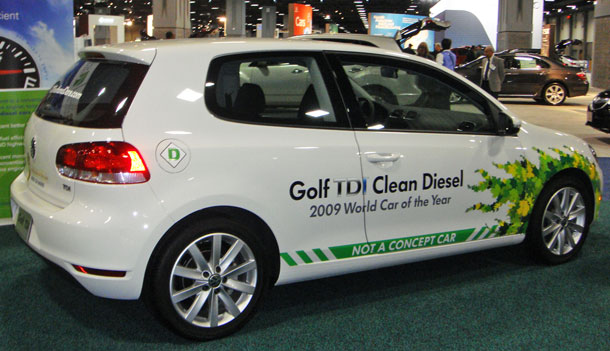
In 2015, the US Environmental Protection Agency found that Volkswagen had programmed their diesel engines to activate emissions controls only during testing, and not during real-world driving. Volkswagen eventually pleaded guilty and agreed to pay $4.3 billion in penalties. (Photo: Mario Roberto Duran Ortiz, Wikimedia Commons, CC BY-SA 3.0)
CURWOOD: And remind us just how big a deal is the company Volkswagen?
MOTAVALLI: Well, it's one of the biggest automakers internationally. It's the Volkswagen Group, it also includes Audi and Porsche and, believe it or not, Bugatti. So it's a big conglomerate, it’s the second largest in the world in terms of just number of cars produced.
CURWOOD: And now as I understand it, Volkswagen is going to start building electric cars.
MOTAVALLI: Yeah, the e-tron is an Audi electric car. It is going to be on the market in a few months, you can take reservations for it now. And following that, we’ll get the Porsche Taycan and these cars will be serious competition for Tesla. If you look at it, Tesla had a number of years, maybe five or six years with pretty much no competition in the fields they’re in. Nobody was producing electric cars with the kind of range, with the kind of price they were offering, and certainly with the performance they have. And it was only a matter of time before the big OEM automakers caught up and started offering similar products. That's happening now, and it's one of the challenges Tesla is facing. Right now, there's still nothing on the market that's comparable to the Tesla Model 3, or the Model S, or the Model X, but those are all coming.
CURWOOD: I understand that they're going to open a car factory for these electric cars. Where and how many jobs would it create?
MOTAVALLI: I think it's something like 1,000 jobs. It's going to be in Chattanooga, where they have their car plant now. It's a very high volume plant, and they're going to be turning these out by 2020. I believe the cars were delayed by a few months, but next year, they're definitely going to be producing a small hatchback there. But there's a number of models that are in the pipeline, including a crossover SUV and version of the Microbus.
CURWOOD: Jim, the cars that Volkswagen Group is putting forward initially, I imagine they're going to go for a very fancy price tag. But my German is wobbly, but I believe Volkswagen means, essentially, the people's car. So what are they going to make that many people can afford to purchase?
MOTAVALLI: Well, the first car that Volkswagen itself is producing is a small hatchback, and they said they're going to produce them at half the price of Tesla. I think that's probably a little exaggerated, it's probably going to be more like maybe two-thirds the price of a Tesla, but they're going to be cheaper than the Tesla and the Volkswagen has said that it's going to be all electric. It's going to produce something like 27 models on one platform. This is a serious, big commitment to electric, which would have never happened if they hadn't been caught with their diesel pants down.
CURWOOD: And how much money is the Volkswagen Group investing in electric cars for this conversion, do you know?
MOTAVALLI: I've heard it’s several billion dollars. Actually, 30 billion in electric mobility as a whole, so it's a big push. It's the commitment by the automaker; they are all in on electric cars. And it's not just demand in the US, there's a number of countries in Europe that are talking about going all-electric, of not even allowing the sale of internal combustion cars. France is an example of this. And already in Europe, a lot of inner cities are reserved for electric mobility only. So, the handwriting is on the wall in Europe. I think the whole world's going this way.
CURWOOD: Jim, before you go, tell me how do you imagine the future of motor vehicles will look like?
MOTAVALLI: I think the future of vehicles is electric, connected, autonomous, and we're going to be getting around in, sort of, cars that are not so much personally owned as shared. The acronym for this is ACES. So it's Autonomous, Connected, Electric, and Shared. And that's where we're headed. All vehicles will be like that. Nobody doubts this, every automaker in the world thinks we're headed this way. So I think ACES is pretty much where we're going.
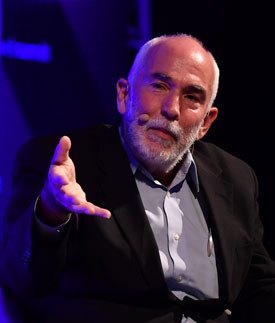
Jim Motavalli is a freelance environmental journalist and blogger for NPR’s Car Talk (Photo: Seb Daly, Web Summit, Wikimedia Commons, CC BY 2.0)
CURWOOD: So, if it's going to be ACES for the electric car, to twist the analogy, the snake eyes is coming up for the internal combustion engine?
MOTAVALLI: I think so. It’s… the timeline of it is very hard to predict. I don't think it's going to happen tomorrow. It may not even happen in this decade. It may be till 2030 or after that. To talk about when we get to the point where people can sit in the back of the car and it can deliver you somewhere…everybody expects that autonomy will look like that. That point is not that close. We have a lot to work out before that happens both in technology, regulation, insurance, all those things, but we're going to end up there.
CURWOOD: And before then?
MOTAVALLI: Before then, we'll have a mix of electric and conventional internal combustion cars on the road, and we'll have more and more autonomy in the cars. Right now a number of automakers will let you have the car be pretty much autopiloted on the highway. I would say another thing that we're seeing is, say, 5G connectivity in the car. So, instead of bringing your car in for an update, it's going to be done over the air. And Tesla pioneered that, but the entire industry has adopted it, so that's another part of what we're seeing. But a mix of cars for the next 10 years on the road. We're not going to be all ACES cars for quite a while.
CURWOOD: Jim Motavalli blogs for NPR’s Car Talk and he's a freelance environmental journalist. Jim thanks for taking the time again today.
MOTAVALLI: It was great to be on.
Related links:
- Fortune | “Volkswagen's Pivot to Electric Vehicles Will Bring 1,000 Jobs to Tennessee”
- More About Jim Motavalli
- Investor’s Business Daily | “How To Make Electric Vehicles Profitable As Tesla, GM Look To Build Millions”
[MUSIC: Barenboim/West-Eastern Divan Orchestra, “Beethoven Symphony No. 9 - Mvt. 2”, Friday 27 July, Royal Albert Hall https://www.youtube.com/watch?v=Tn4lk8fRskA&list=RDTn4lk8fRskA&start_radio=1]
CURWOOD: Just ahead, grooming for spring mating season can start early for egrets in Florida, but first this note on emerging science from Aynsley O’Neil.
Science Note: Using Mushrooms to Save The Bees
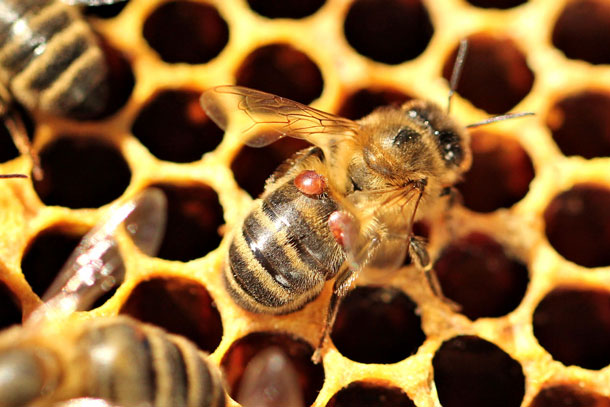
Varroa mites are the tiny parasites that transmit the Deformed Wing virus to bees, thereby giving them shrunken wings and preventing them from flying. (Photo: AbsoluteFolly, Flickr, CC BY-NC-ND 2.0)
[SCIENCE NOTE THEME]
O’NEILL: Deformed Wing virus has resulted in the deaths of billions of bees around the world.
As the name indicates, the virus gives bees shrunken, misshapen wings, which prevents them from flying, and essentially cuts their lifespans in half.
Although the parasitic mite that causes the virus is no more than 2 millimeters in length, it can take down an entire hive by infecting just one bee that transmits the virus to its hive mates.
Even worse, if a sick bee visits a flower, it can transfer the disease to any other bees that come in contact with that plant in the future.
But now a team of scientists has discovered an unexpected potential cure: mushrooms.
After seeing that bees tend to drink water droplets from fungi, a team of scientists theorized that the bees might be doing more than just hydrating.
Amadou and reishi mushrooms have both been used in traditional medicines, but this is the first time researchers have investigated their antiviral properties as a potential cure for Deformed Wing virus.
When bees consumed mushroom extracts in lab experiments, they had an 800-fold decrease in the levels of the Deformed Wing Virus in their systems.
Even in difficult-to-control field experiments, scientists observed an 80-fold reduction in the virus levels after treating hives with the reishi extract.
Now, these scientists are scaling up their experiment by conducting tests in hundreds of beehives throughout the state of Oregon.
That’s this week’s note on emerging science. I’m Aynsley O’Neill.
[SCIENCE NOTE THEME]
Related links:
- Read about this research in the article in Nature
- TED | “6 Ways Mushrooms Can Save The World”
- Learn more about this and other mushroom research
A Great Egret’s Mating Dance
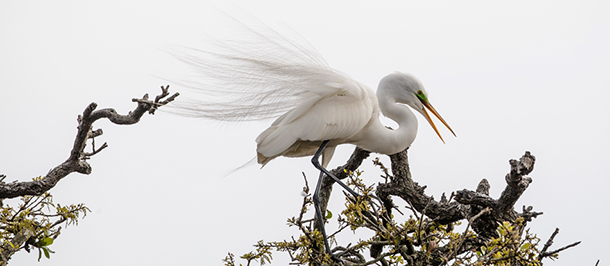
A male Great Egret in his breeding plumage. (Photo: Mark Seth Lender)
[EGRET CALLS]
CURWOOD: Long-legged egrets make their living fishing in shallow waters from Washington State through Central America. They are year-round residents in the Gulf states, including Florida where Living on Earth’s Explorer in Residence, Mark Seth Lender, found a Great Egret getting ready for an early spring.
Not Narcissus
Great Egret
St. Augustine
© 2018 Mark Seth Lender
All Rights Reserved
In the leafless somnambulance of winter the tree sways in the wind, and has not recognized that by all the other purposes of Life it is already spring. The warmth that should be early April has arrived a month too soon. The Order of disorder rules.
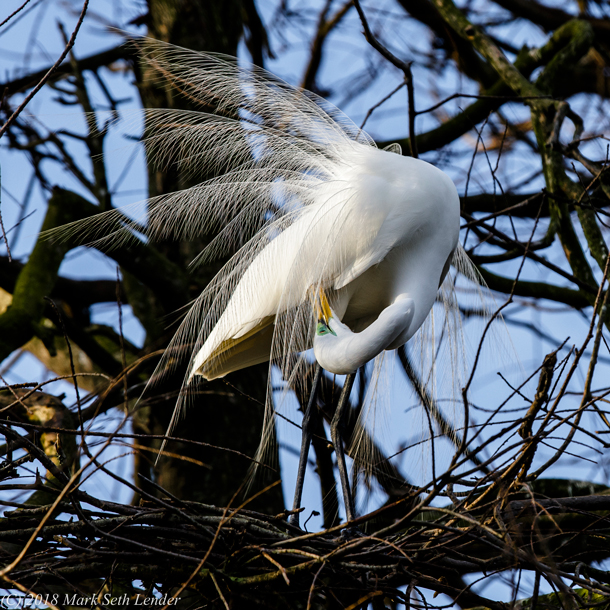
A male Great Egret preens his feathers. (Photo: Mark Seth Lender)
White as the snow that never falls here, white as the clouds that pillow on the sky, white as sequins sewn to the wedding suit of some mysterious groom, now Great Egret has arrived, and found a place of standing. The quills that descend from his back are falling water, the color of his face is emeralds of high degree, his bill is electrum. Canary yellow diamonds are his eyes. He is radiance. He is the glow that displays upon the sunrise sky.
Great Egret bows, the long neck reaches down, the long bill taps sharply on the branches below the branch where he stands (to show how he will find substance for the nest; how he will strike the water to capture fish). He stretches towards the blue above him (to show the way he will defend eggs, then young, and challenge all intruders and unwanted suitors). He strops the feathers and the long decorating quills vibrating along his sides (to show by his perfection how fit he is for the tasks he promises to perform). He sways side to side (a demonstration that his balance is unshakable). He looks straight and long (taking the parallax view of any danger lurking near or far).
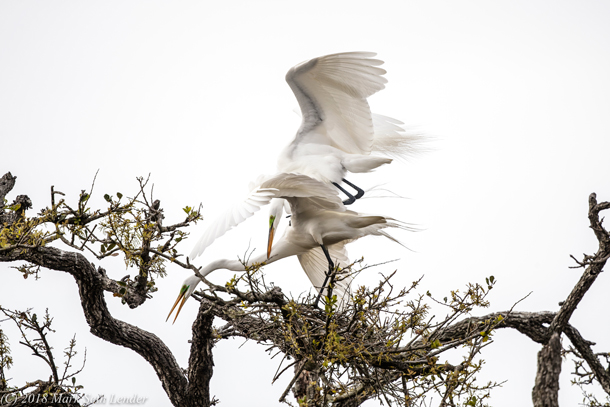
Great Egrets breed in trees close to wetlands. (Photo: Mark Seth Lender)
And just in case you think all this is rote, that he has no idea what it’s all about, and who it’s all for? When the dance is done, like any single dancing son alone at a high school prom, he looks all around as casually as possible so that you’d hardly notice it – a glance here, a glance there – in hope that at the very least, just one of the girls was watching.
CURWOOD: Living on Earth’s Explorer in Residence, Mark Seth Lender.
Related links:
- Mark Seth Lender’s website
- Thanks this week to St. Augustine Alligator Farm Zoological Park
[MUSIC: Darol Anger/Barbara Higbie Quintet, “Egrets”, on Live At Montreux, Sony Music Entertainment https://www.youtube.com/watch?v=f30iMz9Q38s]
CURWOOD: Coming up – A remembrance of educator and conservationist Dick Wheeler and his adventure traveling the migration route of the now extinct Great Auk. That’s just ahead here on Living on Earth. Stay Tuned!
ANNOUNCER: Funding for Living on Earth comes from you, our listeners, and United Technologies, combining a passion for science with engineering to create solutions designed for sustainability in aerospace, building industries, and food refrigeration. UTC companies such as Otis, Carrier, Pratt and Whitney, and UTC Aerospace systems are helping to move the world forward. You can learn more about United Technologies by tuning into the Race to Nine Billion podcast; listen at racetoninebillion.com. This is PRI, Public Radio International.
[CUTAWAY MUSIC: Snarky Puppy, “Thing of Gold (groundUp)” December 16, 2011, at Shapeshifter Lab in Brooklyn, New York, for GroundUP Music]
Remembering Dick Wheeler and the Great Auk
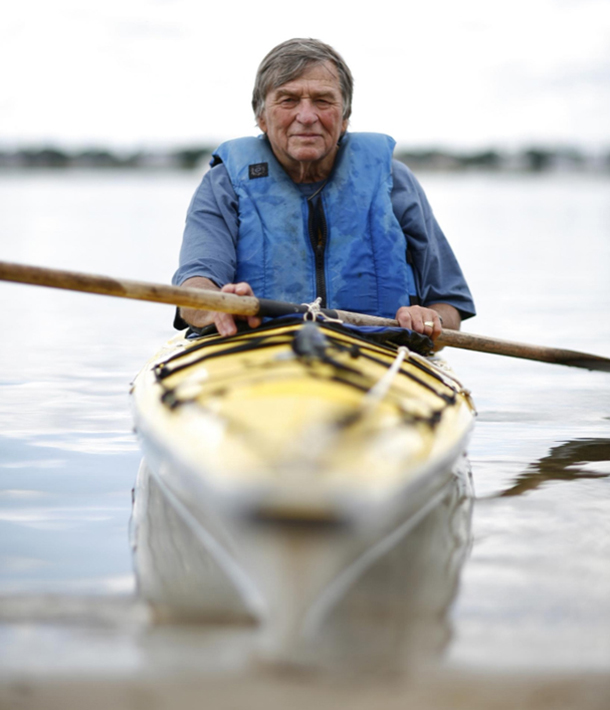
Portrait of Richard "Dick" Wheeler in 2007 on his kayak in Buzzards Bay. (Photo: Courtesy of Cape Cod Times)
CURWOOD: It’s Living on Earth, I’m Steve Curwood.
Great auks were the closest creatures the northern hemisphere once had to penguins. Sadly, these flightless birds were plundered out of existence in the 19th century. To tell the story of the Great Auk, conservationist Richard Wheeler once paddled a kayak from the far north of Labrador Canada to Cape Cod in Massachusetts, and storyteller Jay O’Callahan made a dramatic interpretation we’ll hear in just a moment. We originally broadcast our segment with Dick Wheeler and Jay O’Callahan back in 1999. We are bringing it to you again today because Dick Wheeler recently died at 88, and we thought this tale was a most fitting way to honor this man, whom Time Magazine once named a Hero for the Planet. Here’s that original recording of the Story of the Great Auk when Jay O’Callahan and Dick Wheeler joined me in the studio
O'CALLAHAN: Hey, hey! Dick Wheeler here. Dick Wheeler. Want to talk to you. I'm the Great Auk man. I got a call one day from Dick Wheeler, I didn't know Dick, said he'd heard a sea story of mine on the radio, wanted to talk to me about a journey. He wanted to make a 1,500-mile kayak journey, from northern Newfoundland, a place called Funk Island all the way down to Buzzard's Bay. Well, I've grown up by the sea, and I knew that was almost impossible.
(Music up and under)
CURWOOD: That's Jay O'Callahan telling the story of one man's odyssey, to follow the migratory route of a now extinct sea bird. Dick Wheeler grew up on the sea in Marshfield, Massachusetts. The winter he was ten years old, he built a kayak with his brothers and his father. And though his life would take him in many directions, to college, to the Navy, to a lifelong career as an English teacher, building that kayak planted in him a dream he would never forget: a long paddle at sea.
(Music up and under)
CURWOOD: A half-century later, at 60 years of age, Dick Wheeler was in his kitchen one night, dinner for his wife simmering on the stove, when he picked up a book he hadn't read in years. It was called The Great Auk, and it was about a bird of the same name.
O'CALLAHAN: Somewhere over five million years a decision was made inside the species of the Great Auk not to have hollow bones. It gave up flight in the air. The decision was for solid, dense bones, so it could be a great plunge diver. With the solid bones it could plunge straight down the sea 100 feet. That's a long way down. But if it needed 200, 300 feet, 400 feet, 1,000 feet, it could soar under the sea with the grace of an eagle and the ease of an eight-year-old girl in a swing. It was a magnificent bird, and smart.
(Music up and under)
CURWOOD: That dinner never got cooked. Instead, Dick Wheeler had already put in for the adventure of his life: a paddle tracking the Great Auk's migratory journey south. His wife, Sandra, said simply, "Keep the land on your right." That began two years of planning and training for his trip. Along the way, Dick learned of storyteller Jay
O'Callahan. He tracked him down and asked if he would help tell the story.
Recently, Dick Wheeler and Jay O'Callahan joined us in our studio, to tell and perform the story of Dick's remarkable journey. Dick told me more about the bird that inspired him.
WHEELER: Probably, the best diving bird the northern hemisphere has ever seen, perhaps in the world. It stood about two feet tall, mated for life, they laid just one egg a year, an enormous egg.
CURWOOD: The same dense bones that gave the Great Auk its miraculous diving ability also left it unable to fly. Most of the year it was safe in the water, but during the six weeks or so it needed to breed each summer, it was land-bound. And when explorers moved further into uncharted waters of the North Atlantic, the Auk was unable to protect itself.
WHEELER: They existed in such numbers that the earliest ship's captains, who were used to an abundance that we've never seen, became very emotional in their logs. There were so many of these birds, they'd say, "No matter how many we kill, there will always be more." And they filled boats with them, and then they filled boats with their eggs, and then they put their flesh into barrels, and then New England fishermen went up and took them and cut their breasts out for bait for codfish. And the final blow, or close to the final blow, came when the mattress industries that were developing in the United States, in Nova Scotia, needed feathers. And having depleted the eider duck populations, someone said let's go out to Funk Island and get those Great Auks. And so they did. And they got them all.
(Music up and under)
CURWOOD: The first leg of Dick Wheeler's journey was a treacherous 40-mile paddle across the open ocean in from Funk Island, one of the Great Auk's summer breeding colonies. Then he headed south down the coast of Newfoundland in his 17-foot kayak, nicknamed "Aukie." Upon her bow he'd mounted a figurehead of the Great Auk he'd carved and painted himself. Storyteller Jay O'Callahan.
O'CALLAHAN: Paddle on the left side, paddle on the right, paddle up a wave and down the other side. Paddle on the left side, paddle on the right, paddle up a wave and down the other side. We're doing the dream, Aukie, we're doing the dream! Look at that, guillemots all around us. Beep beep beep beep beep! Well, Aukie, I'm tired. I'm going to put in right here. Look at that fisherman. Chin looks like a doorknob, looks like he's waiting for us.
"Hey boy, you're the one that come in from the Funks, boy?"
"How'd you know that?"
"Everyone in Newfoundland knows about you, boy. We heard about you on the fishing radio. You come all the way in from the Funk for nothing. I wouldn't go across the harbor in that thing, boy. How about some tea?"
Hey, when you're 60 and someone calls you "boy," makes you feel good. We went up to his house and aah, kitchen smelled good, children gathered round as if I was a Great Auk, and I sat down, had my tea, and then the woman of the house opened the oven. Took out a fresh loaf of bread. Gave me a knife. I sliced it. Steam came out and (laughs) I put potted berry jam. I love potted berry jam. (Laughs) Well, they kept looking at me, so I ate the whole loaf. An the woman of the house set down a whole plate of cod cheeks, big treat up there.
I ate that and said, "I can't move."
She said, "I would hope not, not before the caribou steaks."
"Two steaks! I said, "I can't set the tent up now."
"Of course you won't. You'll be sleeping in the bedroom."
"I can't do that; it's your bedroom."
"My husband and I love to sleep on the kitchen floor, good enough."
I call this aggressive hospitality. So the next morning, getting up she said, "Hey, boy, how far are you going today?"
"I'm still tired. Maybe ten, fifteen miles."
"Give me the chart, give me the chart, box, and I'm going to make a little "X" on the tickle. A tickle is a narrow opening in the rocks. You put in a tickle you'll smash up on the surf. Here you go. Now, boy, tell them, we shouldn't be catching the babies."
"What?"
"Tell them we shouldn't be catching the babies. They're going to listen to you."
"Who's catching babies?"
"We're catching the baby codfish is what I'm talking about."
"Why are you catching the baby fish?"
"Because the government lets us. These are cold waters up here. It takes six or seven years for a cod to grow up or they don't grow up any more. Don't tell me to stop fishing; I've got the family right here. If I stop fishing everyone's going to say I'm crazy, and they'll keep fishing. But we shouldn't be catching the babies. Now tell them, please; they'll listen to you."
(Music up and under)
CURWOOD: Dick, this is a recurring theme through your trip: don't catch the babies?
WHEELER: The best illustration of that is a blackboard that I saw in one of the ports on the way down, where they had painted over a blackboard, "We will accept no cod shorter than 24 inches." The "24 inches" had been crossed out,"23 inches" written in. Twenty-three had been crossed out. Then they had written in 22 and crossed that out. And when I got to the port they were down to 19 inches. And a 19-inch cod is a very small fish. A third of the fish is head. And in fact, that's the reason they stopped the offshore fishery. The mechanical filleting machines couldn't handle the small cod. So they stopped the fishery.
(Music up and under)
CURWOOD: Dick Wheeler's trip had started out with a straightforward goal, to use the kayak as a symbol for the Great Auk and bring recognition to other sea birds. But it was quickly turning into a very literal, very immediate story about an entirely different species: fish that were not extinct but in trouble. As Dick moved south and crossed the border into Maine, he found that not everyone saw the problem in the same way.
O'CALLAHAN: Deedle deedle deedle deedle deedle deedle dee. Aukie, we're in Maine, Maine, I love Maine, Aukie, smell that seaweed! My second home, Aukie, ho ho! Paddle on the left side, Auk you're going to go right up there. Bar Harbor. Going to go up and have a cup of coffee at that diner. When I went up, and this is late October but there are tourists all over, I could tell, they're dressed right out of the catalogues. Went into a diner and I felt uncomfortable, too big for the place. The place was jammed. Sat down to the counter.
"A cup of coffee, please."
And there's a prosperous looking couple in their late 50s beside me. The man had the half-glasses. He was reading the Times. His wife had the New Yorker. I couldn't resist. I tapped half-glasses on the shoulder and I said, "I notice the headline on the Times says Storm Wreaks Havoc With Environment. I always thought storms were part of the environment."
Half-glasses looked over his glasses;" I thought it was funny." Then the three of us looked up at CNN, the television, there was an economics professor. "We have to make choices, economic choices. For instance, if you're the whaling industry and you take a 15 percent profit for three years, the whales are gone. If you take a ten percent profit for three years, there's a sustainable yield. What do you take?"
And I said to half-glasses, "Well, of course, you take ten percent."
He said, "No, you take fifteen percent for three years. Then you reinvest the capital elsewhere."
"Then the whales are gone!" I hit the coffee cup. It smashed so I got out of there.
(Music up and under)
O'CALLAHAN: I paddle along, said Aukie, look, look at that house, that's our savior. All the lights going on in that big house, it's a family come for the weekend in Maine. Maybe they'll let us tent out in the front yard. (Laughs) So I knocked on the door. A great big red-headed fellow opened up.
I said, "I'm sorry to bother you. I'm Dick Wheeler. Can I tent out in the front yard? I'm doing 1,500 miles in a kayak."
He said, "Come on in, Rick. Come on in, Rick. Step on the newspaper, will you?"
His friend is watching the game. "I'll be right in. I've got a fellow Rick, he's doing 15 miles in a kayak."
"Fifteen hundred."
"Whatever, Rick, whatever. Listen, Rick, we've got to take care of one another. I'd be worried about you with a hard frost, so use the phone."
"The phone?"
"Yeah, call the motel, Rick."

The Great Auk went extinct in 1844 and was once affectionately known as “Buzzards Bay’s Penguins.” (Photo: Wikimedia Commons, Jim the Photographer, CC BY 2.0)
(Music up and under)
WHEELER: I guess one of the things the trip taught me was that we have a different meaning for hospitality in America. You could just drift ashore in a log in Newfoundland and live in that place forever. They will truly give you the shirt off their back if it is the last shirt they have. America is quite different, and I always thought of us as a hospitable culture, but we fail if we compare ourselves to Newfoundland.
CURWOOD: And our sense of natural capital? This fellow said to you: well, if we use it up, we'll invest the profits elsewhere. What does it matter?
WHEELER: Oh, I think that's very true. You see that all the time. In our own fishing industry, when we deplete one resource we look around for something that is abundant. You'll hear people say well, we've fished out the cod, there are more mackerel out there than we'll ever be able to catch. Let's go get them. And you hear people say, well, when we've fished out the sea, we'll just learn to farm them. We did it on the land and we'll learn to do it with fish. We need to realize that the National Marine Fisheries Service has a lot of wonderful scientists in it, good, good people. But the fact is that it comes under the Department of Commerce. So the overall responsibility is to catch more fish, create more jobs, and find more markets for more.
CURWOOD: When the government brings out all the numbers about the catches and this and that, how does that resonate with you once you've been out on the water for this period of time? Do all those statistics mean anything when you ride the waves in a 17-foot-long boat?
WHEELER: The trip has convinced me that the problem is not an economic problem, as most people see it, but that it is a spiritual problem, in the sense that the relationship we have with the ocean is tragically flawed. The fact that we think it was put here for us, which links into the feeling that the best of us will get the most of what was put here for us. So there are some deep-seated spiritual values that are contributing to this, that need to change over time. And it will take time. It's going to take a dramatic change, and it will not come probably until there has been a collapse.
(Music up and under)
CURWOOD: Dick Wheeler says a spiritual awakening is one part of his trip he had a hard time expressing himself. It's one of the parts he most needed a storyteller for.
O'CALLAHAN: It's a cold November day, but all we have to do is finish up. No more excitement. Paddle on the left side, paddle on the right. Be done in ten days, Aukie, beep beep beep beep beep beep. Aukie, did you hear some guillemots? Thought I heard guillemots. Guess not. Paddle on the left side, paddle on the right. Beep beep beep beep beep beep. Where are they, Aukie? (Makes pursing sound with lips) Sounds like a razor belt . There's nothing here, Aukie. (Makes engine sound) My dear child, we caught the spawning fish. Tell them they're not coming back! Aukie, oh no, oh no, come on, let's finish it up, Aukie. Work up a sweat, Aukie, so you could tear me apart. Come on, Aukie, paddle on the left side. Listen, Dick. No! Listen, my honey. No. Listen Dick. No. Listen. All right, all right, all right! (Make shushing sounds) Tell them. Tell them I cannot do it any more. (Shushing) Tell them I cannot cleanse myself as quickly as they foul me. (Shushing) Tell them I cannot replenish all they rip from my womb. Tell them. (Shushing) Tell them. Tell them. Tell them. Tell them. (Shushing) Aukie, did you hear? What a beautiful voice. A tired voice.
O'CALLAHAN: (Makes shushing sounds; sounds of wind) Beep beep beep beep beep beep. (Makes pursing sound through lips, more shushing)
CURWOOD: Portland, Maine, to Cape Cod was another 120 miles, and when Dick Wheeler finally paddled through the Cape Cod Canal, there were more than 100 people awaiting his landing.
O'CALLAHAN: November 16th, Aukie. Cape Cod Canal. That sand, look at all these people. (Laughs) Look at all these people! All you people came to (laughs) see me come in, thanks. You don't know what it meant to me. You gave me the courage to tell you what happened. Now I'm tired; I'm headed home. Dick Wheeler turned and eight of us without thinking picked up Aukie, put Aukie in the back of the pickup truck. Sandra was driving, so we watched Dick, and he was going to the passenger side, and he walked with that wonderful rhythm of the Great Auk. He got in, slammed the door. They drove off, and Dick rolled down the window. He was looking towards the sea. Deedle deedle deedle deedle deedle deedle dee, sshhhhhh! Ssshhhh! (Wind sounds) Beep beep beep beep beep beep Ssshhhhh!
(Music up and under)
WHEELER: I really did see it as if I was being tested by the ocean itself, you know, is this guy for real or is he a faker? And the way the wind went up, you could almost hear a click as the wind went up each notch. And once I got through that barrier, it was almost as if I was visiting another world each day and then coming ashore into the world that I'd grown up in. So I was getting different understandings that really changed me forever.
[MUSIC: Vanhaa valssia, “Troka” on Troka, Olarin Musiikki]
CURWOOD: Once he completed his trip in November of 1991, Dick Wheeler took his message to hundreds of classrooms throughout the U.S. and Canada. Dick taught about the ocean and reminded people that even things that seem abundant can be very fragile, a fine legacy for a man who is now gone but thanks to his life of commitment is not forgotten. Jay O'Callahan's story "The Spirit of the Great Auk" is available from Artana productions in Marshfield, Massachusetts.
Related links:
- PBS NOVA’s The Haunted Cry of a Long Gone Bird
- More About the Great Auk
- TIME | “Richard Wheeler: What a Long-Gone Bird Tells Us About Today”
- Wareham Week | “Remembering Richard Wheeler: A look at the Onset icon’s life”
- More about Jay O’Callahan
[MUSIC: Vanhaa valssia, “Troka” on Troka, Olarin Musiikki]
CURWOOD: Living on Earth is produced by the World Media Foundation. Our crew includes Naomi Arenberg, Bobby Bascomb, Delilah Bethel, Thurston Briscoe, Jenni Doering, Don Lyman, Lizz Malloy, Aynsley O’Neill, Jake Rego, Adelaide Chen, and Jolanda Omari. Tom Tiger engineered our show. Alison Lirish Dean composed our themes. You can hear us anytime at L-O-E dot org, iTunes and Google play- and like us, please, on our Facebook page - PRI’s Living on Earth. We tweet from @livingonearth. And find us on Instagram at livingonearthradio. I’m Steve Curwood. Thanks for listening!
ANNOUNCER: Funding for Living on Earth comes from you, our listeners, and from the University of Massachusetts, Boston, in association with its School for the Environment, developing the next generation of environmental leaders. And from the Grantham Foundation for the protection of the environment, supporting strategic communications and collaboration in solving the world’s most pressing environmental problems. Support also comes from the Energy Foundation, serving the public interest by helping to build a strong, clean, energy economy and from Carl and Judy Ferenbach of Boston, Massachusetts.
ANNOUNCER 2: PRI, Public Radio International.
Living on Earth wants to hear from you!
Living on Earth
62 Calef Highway, Suite 212
Lee, NH 03861
Telephone: 617-287-4121
E-mail: comments@loe.org
Newsletter [Click here]
Donate to Living on Earth!
Living on Earth is an independent media program and relies entirely on contributions from listeners and institutions supporting public service. Please donate now to preserve an independent environmental voice.
NewsletterLiving on Earth offers a weekly delivery of the show's rundown to your mailbox. Sign up for our newsletter today!
 Sailors For The Sea: Be the change you want to sea.
Sailors For The Sea: Be the change you want to sea.
 The Grantham Foundation for the Protection of the Environment: Committed to protecting and improving the health of the global environment.
The Grantham Foundation for the Protection of the Environment: Committed to protecting and improving the health of the global environment.
 Contribute to Living on Earth and receive, as our gift to you, an archival print of one of Mark Seth Lender's extraordinary wildlife photographs. Follow the link to see Mark's current collection of photographs.
Contribute to Living on Earth and receive, as our gift to you, an archival print of one of Mark Seth Lender's extraordinary wildlife photographs. Follow the link to see Mark's current collection of photographs.
 Buy a signed copy of Mark Seth Lender's book Smeagull the Seagull & support Living on Earth
Buy a signed copy of Mark Seth Lender's book Smeagull the Seagull & support Living on Earth

